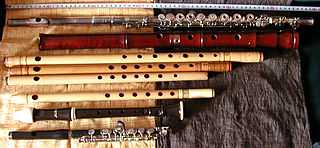Tone hole


A tone hole is an opening in the body of a wind instrument which, when covered, alters the pitch of the sound produced. Tone holes may serve specific purposes, such as a trill hole or register hole. A tone hole is, "in wind instruments[,] a hole that may be stopped by the finger, or a key, to change the pitch of the tone produced."[1]
The resonant frequencies of the an air column in a pipe are inversely proportional to the pipe's effective length. For a pipe with no tone holes, the effective length is the physical length plus corrections for end effects. A shorter pipe, in other words, produces higher notes. An open hole in the side of the pipe shortens the pipe's effective length and therefore raises the pitch of the notes it produces. Generally a large hole in a given position reduces the effective length to something slightly larger than the effective length of a pipe cut off at that position; a smaller hole produces a longer effective length. Covering the hole with a finger, or with a pad operated by a key, increases the effective length and lowers the pitch again. However, a pipe with a closed tone hole is not acoustically identical to a pipe with no hole; the closed hole modifies the pipe's shape and its effective length.
When there are multiple toned holes, the first (highest) open toned hole usually has the largest influence on the pipe's effective length. However, closing holes below the first open hole can lower the pitch significantly; such cross fingerings may often be useful. Generally the pitch and timbre of the notes produced will depend on the positions, sizes, heights, and shapes of all the tone holes, both open and closed. Theoretical models allow these effects to be calculated with some accuracy, but the design of tone holes remains to some degree a matter of trial and error.
Most woodwind instruments rely on tone holes to produce different notes; two exceptions are the slide whistle and the willow flute. Most brass instruments use valves or a slide instead of tone holes, with the rare keyed bugle and the ophicleide as exceptions.
See also
References
- ↑ William Lines Hubbard, ed. (1908). The American history and encyclopedia of music, Volume 10, p.532. Squire.
| ||||||||||||||||||||||||||||||||